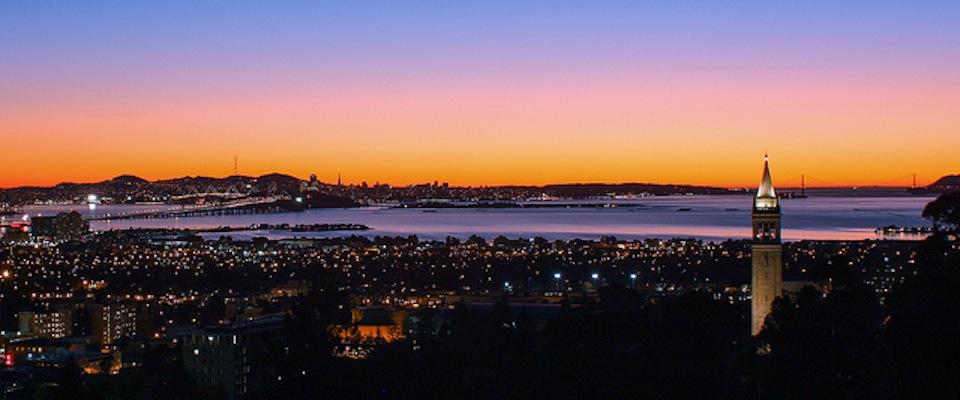As pioneers of social and political justice, UC Berkeley students have always had a reputation as advocates for change. Now, however, some are organizing to halt change—in this case, a proposed downtown development that critics say would block the view of the Golden Gate Bridge from the foot of Cal’s Campanile.
The proposal that would diminish the vista from beneath the world’s third-largest bell-and-clock tower: an 18-story complex proposed for 2211 Harold Way, next to the Hotel Shattuck. The “Residences at Berkeley Plaza” complex will include “302 residential units and grand resident amenity spaces, quality retail and restaurants, and brand new state-of-the-art cinemas,” according to the development’s website. The project, funded by HSR Berkeley Investments, LLC, has garnered criticism from people who oppose the demolition of Shattuck Cinemas, and from students such as Alexandra Smith, a junior psychology major who started a petition urging city council members, Mayor Tom Bates and Berkeley Chancellor Nicholas Dirks to protect the view.
The mayor’s office and planning commission declined to comment on the development, which will again be brought up for discussion at a City Council meeting June 30th. The Berkeley Planning Commission and the Rhoades Planning Group, the consultants hired to design the building, also declined to comment.
The principal planner with UC Berkeley Capital Projects, Jennifer McDougall, characterizes the view discussion as “severely overblown.” In an email sent to the petition organizer, she wrote that “in every view that shows an impact, the view is taken from a far right position on the steps below the Campanile. The same view, from the left side of the steps, would show the view severely obscured by (the university’s Valley Life Sciences Building). The view to the Golden Gate from the Campanile and its environs is, I believe, quite secure for future visitors.”

At a proposed 180 feet tall, the new building would rise far above the Hotel Shattuck (71 ft) and downtown Wells Fargo building (162 ft)—altering the feel of downtown and restricting the view of the bay from campus. Students such as Smith and Associated Students of the University of California senator Madison Gordon say the view offers beauty, relief from stress, and a feeling of connectedness with San Francisco and the outside world. It also helped give Berkeley its name. In 1866, two years before the University was founded, a group of college trustees stood on the site where the campus now exists. As they looked out over the San Francisco Bay, Frederick Billings recalled a poem by an Anglican bishop, George Berkeley, about Western education:
Westward the course of empire takes its way;
The first four acts already past,
A fifth shall close the Drama with the day;
Time’s noblest offspring is the last.
Never mind that notions of empire have become anathema to most of Berkeley’s denizens these days; the poem and more importantly, the name, stuck, and the founders christened their new community “Berkeley.”
Some 3,500 people have signed the petition so far, adding comments denouncing the development as “sacrilege” and arguing that “Change is unavoidable but some traditions are worth protecting.” Many have described moments when the view made them proud to be a Cal student, or offered them relief from anxiety. Gordon contends it would be a “dangerous trend to be ignoring or putting aside Berkeley voters’ views for what I would consider a small gain.”
In addition to promoting its historical and sentimental value, critics argue that the development does not provide affordable housing for the city—one of the reasons the mayor, a Cal alum, previously cited in favor of the development. The Berkeley Downtown Area Plan requires any new downtown development to provide some affordable housing (or pay a $20,000 fee), and states that any development taller than 75 feet must provide other significant community benefits, such as “supportive social services, green features, etc.” The plan for the new building claims that it will boost Berkeley employment opportunities, and that the space will include a residential garden and a publicly accessible plaza with dining options. The target residents of the new building would, according to the Conceptual Project Application, be “young professionals and retirees who want to live in an upscale amenity-rich building…and are expected to have higher levels of discretionary income.”
The project’s promotional website notes that the city’s Downtown Area Plan acknowledges the need to embrace new and old, and insists the following excerpt from the plan sounds as if it were written with the Residences at Berkeley Plaza in mind: “While Downtown’s historic assets are significant, Downtown is an incomplete and unfinished cityscape. It has many underused and nondescript properties, and it needs many public improvements. New development can bring many benefits, including new residents, affordable housing, environmental sustainability, and a renewed sense of vitality. (Therefore) seek to harmonize and balance the twin goals of preserving and enhancing historic resources, and encouraging new and complementary development.”
Smith say she and other critics of the proposal aren’t adamantly opposed to the idea of a development, and might even support this project if developers modify plans so that it doesn’t interfere with Berkeley history. “It’s the 100-year birthday of the Campanile,” she says. “I personally would like to see it preserved for the next 100 years, so I can take my children there to see the view.”





















